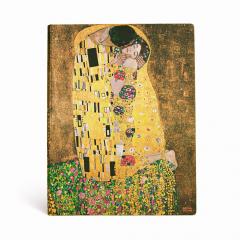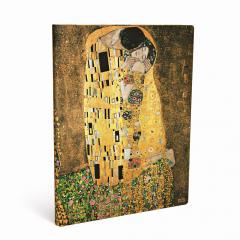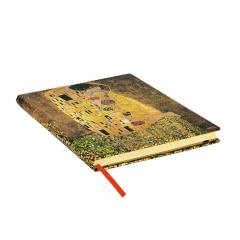The Kiss (1907–1908), the Gustav Klimt painting reproduced here, represents the pinnacle of his “golden phase.” Oil and gold leaf combine to create shapes and colours reminiscent of the Arts and Crafts and Art Nouveau styles. The lustrous palette and intricate patterns make the work a great masterpiece of the period.
2018 marked one hundred years since the death of one of the most significant artists of modern times, Gustav Klimt (1862–1918). To pay tribute to his daring artistic vision, we’ve created two Special Edition covers that spotlight his “golden phase.” During that period he painted these iconic pieces, destined to rouse instant recognition in both serious art lovers and those who simply have an appreciation for beautiful artifacts.
Klimt attended the Vienna School of Arts and Crafts where he trained as an architectural painter. As he painted interior murals and ceilings in public buildings, his technical ability endeared him to Vienna’s conservative haute society. But soon, his inner boundary-pushing style came through, causing too much of a stir for the culturally reactionary class who had initially welcomed him so openly. Three paintings he created for the University of Vienna were rejected – deemed “pornographic” – and so he took his talents elsewhere.
Klimt’s response to the scorn was to found the Vienna Secession, an avant-garde movement that treated art as a space for exploring possibilities rather than following the academic tradition. From then on, he was an artistic renegade contributing to the cultural fermentation of turn-of-the-century Vienna. He painted mostly portraits of the progressive society ladies who were his patrons. His works were often erotically charged, exotic, mystical representations, marking him as a Symbolist painter.
Klimt was firmly convinced that there should be no separation between so-called “low” and “high” forms of art. His canvasses were filled with organic forms reminiscent of the earlier Arts and Crafts movement as well as decorative patterns suggestive of Art Nouveau, both styles that were oriented towards this principle of universal art.
Featuring linear patterns and tender florals, Klimt’s famous The Kiss, reproduced here, shows itself as a direct descendant of these two styles. The speckled golden shimmer of the painting’s background, common to much of the work that Klimt produced during his “golden phase,” was attributed to his fascination with the look of Byzantine religious mosaics that he saw during his travels in Venice and Ravenna. He was also enthusiastic about traditional Japanese art, which would have inspired his flat backgrounds done with the use of gold leaf.
Klimt engaged in many affairs throughout his life, but from the early 1890s until the last of his days he also enjoyed a loyal, though likely platonic, relationship with Emilie Louise Flöge, an Austrian fashion designer. It is believed that the couple captured in a moment of intimate rapture in The Kiss is a depiction of the great painter and his lifelong companion.





